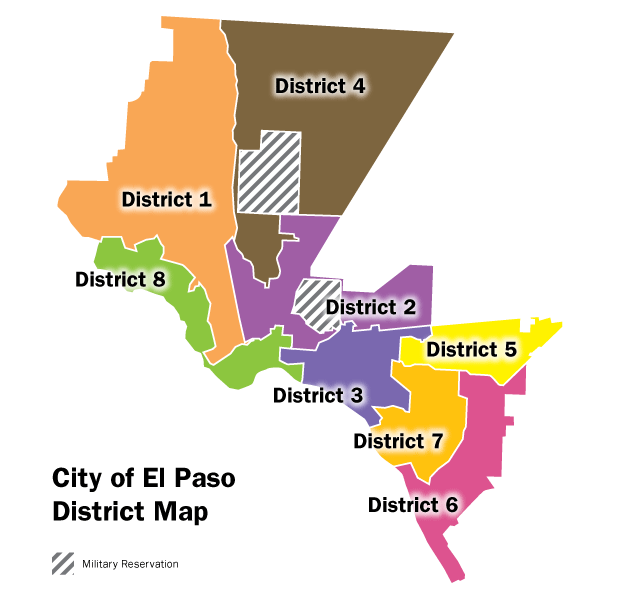If you only read the local newspapers, and maybe watch the City Council meetings on the internet, you might not know how poor El Paso is. According to this article from CBS News, El Paso is the eighth poorest city in the U.S. If you want to compare paychecks, Forbes pegs us at 97th out of the hundred biggest Metropolitan Statistical Areas in the country.
You don’t see those rankings scrolling across the electronic signboards on the city’s buses.
How can the City, and the media, ignore this economic reality?
Have you examined a map of the City’s legislative districts?
Except for a few pockets of opulent abundance, poverty is widely distributed in El Paso. But the poorest zip codes are south of the freeway.
See how the poorer neighborhoods have had their political power diluted by slicing them up and dividing them among wealthier districts? Districts 8, 3, 7, and 6 all get a chunk of the neighborhoods south of the freeway, while the bulk of those districts are composed of wealthier areas north of it.
If City Government, and their puppet masters, wanted to be fair about local governance, they’d have given the poor their own representative on City Council. There’d be a district for people south of the freeway. Instead City Council gerrymandered the districts to dilute the influence of our gente humilde.
Maybe you think that’s a good thing. Like maybe we don’t need to give those largely less educated a seat at the table. But despite your fantasies and aspirations, the interests of the poor largely coincide with the middle class majority of El Pasoans more than the fat cats.
Look at District 8. If the interests of the wealthy people in District 8, who live in the Willows and the Upper Valley, conflict with the interests of the people in the Segundo Barrio, how do you think the representative for District 8 will vote? The gente in Segundo don’t vote much, whereas the wealthy folks in the Upper Valley not only vote, they contribute to campaigns.
Politicians complain about our low voter participation rates in El Paso, but how can you expect people to vote if they’re not represented?
The system is so ingrained that the humble people along the border are grateful for whatever crumbs the city gives them. They need a champion to lift them up, instead of politicians who sell them out.


These districts are indeed ingrained, and there is likely very little to be done to change that. All I know, as a former employee of YISD (whose wife also worked there for many years, as a classroom teacher) and the former City/County Health Department, is that the money always goes above I-10, and the Valley gets the leavings. And, yes, none of our current districts have fair representation. But, I suspect we have as good a chance of changing our local districts as we do changing the gerrymandered districts across the State.
The districts have to be changed every ten years in response to the census results. It would probably take a lawsuit to get them changed any sooner. To get the problems of southside representation addressed would require political will, and there seems to be a distinct shortage of backbone among our elected officials.
These districts were changed after the 1990 census. A couple of the districts used to be below the freeway. But in 1990, a City committee revised the boundaries to go above and below the freeway.in the “unstated” belief that the “below the freeway voters” would control the district. The opposite occurred. JJ Arms got beat by an above the freeway candidate and that was the end of it. The jerry mandered district 8 had the same results…the Willows voters control it. A resource for this is Sebastian Martinez. I think he was chair of the committee. I sat in on a couple of meetings. BE CAREFUL WHAT YOU ASK FOR.
That’s poetic justice, I guess, but it still leaves the voters south of the freeway un- or under-represented on City Council today.